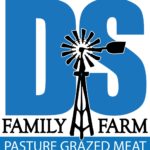Worried about what you are "really" eating? Have peace of mind with pasture grazed meats.
Grassfed vs Conventional Beef – Voodoo or The Difference is Real?
I recently visited with a friend who shed some weight over the past year, when I asked how he lost the weight, he replied “improved my diet”. He obviously “gets it”, notice he didn’t say he was on some kind of “diet” he just changed to a “healthy diet”. One specific diet change he mentioned was that he was eating grassfed beef rather than conventional beef. We discussed the “known” benefits of grassfed and then he pointed out that his son, who raises conventional beef, refers to grassfed as “Voodoo Beef”!
With our first Pasture Grazed, 100% grassfed beef in the freezer, it was time to find out for ourselves, is there really a difference between a pasture grazed beef compared to typical (corn-fed) beef?

We sent in a rib steak (ribeye after removing the bone) from a 2015 harvested steer to Midwest Laboratories in Omaha Nebraska for analysis. With the results in hand I searched out some “typical” beef analysis to compare our pasture grazed beef with. It didn’t take long and I had two similar† “reference” samples from the USDA and Canada nutrient databases. Below we compare a DS Family Farm Pasture Grazed steak to some “typical beef” steaks – Canada record 6068 and USDA record 23271.

Let’s Talk FAT!
- Trans Fat? Yes there is natural Trans Fat in beef, not the added hydrogenated vegetable oils (bad stuff).
- Looking at the above three samples, I believe the Food and Drug Administration (FDA) rules would allow all steaks to be labeled as ZERO TRANS FAT since they are all 0.5 or less. So when you check any food product label, if it says ZERO TRANS FAT, it may actually not be “zero”.
- Always avoid food items with any ingredient listed as “partially hydrogenated“.
Warning – pie charts below!

- Chart 1 – ALL FATS – do not fear good grassfed fat!
- I was once brain washed with the “fat is bad for you” message. I believe more folks are understanding it is High Carbohydrate Diets (Low Fat diets) that can be linked to heart disease and diabetes. This study at Ohio State University points out:
- Increasing levels of carbs in diet during the study promoted a steady increase in blood fatty acids.
- Carbs are being converted to fat instead of being burned as fuel.
- Reducing carbs and adding (good/portions) fats ensures the body will promptly burn saturated fat as fuel. (This will take a resetting period for your body to switch between using carbs vs. fat for energy).
- Please watch the OSU video that points out your brain is 60% fat! Eat fat to fuel your brain!
- Chart 1 displays a noticeable difference between SFA – Saturated Fatty Acids versus MUFA – Monounsaturated Fatty Acids in grassfed vs. conventional, we will look at these individually below.

- Chart 2 – SATURATED FATTY ACIDS (SFA)
- Note in Chart 1 = 60% of the fat from our pasture grazed beef is SFA vs. around 50% of typical beef is SFA.
- Chart 2 = two main SFA, Palmitic (tropical oil) and Stearic is better balanced (?) in our beef versus typical beef.
- Tropical (palmitic) oils are gaining favor with nutrition folks, get yours from our Midwest 100% grassfed beef!

- Chart 3 – MONOUNSATURATED FATTY ACIDS (MUFA)
- Note in Chart 1 = 35% of the fat from our pasture grazed beef is MUFA vs. around 50% of typical beef is MUFA.
- Chart 3 = primary MUFA is oleic acid, also known as Olive Oil.
- Grassfed has a higher percentage of the SFA Palmitic (good fat, chart 2) but a lower Palmitoleic MUFA (bad fat, chart 3).
- According to the OSU study, in humans, “Palmitoleic acid, a fatty acid associated with unhealthy metabolism of carbohydrates that can promote disease”. Could this apply to cattle also?

- Chart 4 – POLYUNSATURATED FATTY ACIDS (PUFA)
- Note in Chart 1 = 4% of the fat from all three sample is PUFA.
- The Holy Grail of Fatty Acids
- The Essential Fatty Acids
- Notice a difference? Hint – a balance of green & yellow is recommended.
Stay tuned we will dive in to the PUFAs in our next post!
† I selected these reference samples because they were of the same part of the beef. We sent in a Rib Steak which is a Ribeye with a rib bone still attached. The bone was removed, so our sample was a ribeye when analyzed. I consider our beef lean so the selected reference samples used were identified as “lean”. We are still building our soils and forages and striving for higher fat (marbling) percentages in our beef.
Note, I am not an expert on fats nor statistical analysis. Feel free to dive into the Government data and check my calculations for the two samples listed above. If you find any discrepancies, please email me: doug@dsfamilyfarm.com. If you have comments please share them on our Facebook Page.





Pingback: Grassfed beef - fat analysis - omega 6 to 3 ratio - D S Family Farm